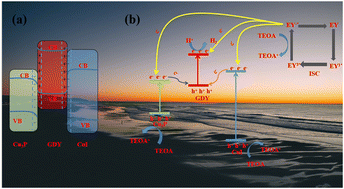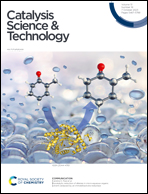Phosphating core–shell graphdiyne/CuI/Cu3P S-scheme heterojunction confirmed with in situ XPS characterization for efficient photocatalytic hydrogen production†
Abstract
Graphdiyne (GDY), a new 2D hybrid carbon material, has been praised for its distinct structure and chemical properties since its synthesis in 2010. In recent years, graphdiyne has been continuously applied and studied in photocatalysis, where it has shown excellent photocatalytic performance. In this paper, the core–shell encapsulated ternary catalyst graphdiyne/CuI/Cu3P is obtained by phosphatizing the partial CuI phosphate on the outer surface to Cu3P. The calcined ternary catalysts are closely connected with each other, with larger contact area, more active sites and faster electron transfer efficiency, thus greatly improving the hydrogen evolution rate. The double S-scheme heterojunction structure can effectively separate electron holes and induce the directional migration of electrons, maintaining the best redox ability of the catalyst to achieve more effective photocatalytic hydrogen evolution reactions. Graphdiyne/CuI/Cu3P showed good hydrogen evolution efficiency, and the H2 production efficiency was conspicuously improved. In this work, the structure and energy band of the catalyst were studied through in situ XPS and DFT calculations, among others, to verify the possible formation of a double S-scheme heterojunction between graphdiyne, cuprous iodide and cuprous phosphide. The preparation method of the catalysts is simple and effective, providing ideas and strategies for designing high-performance catalysts.



 Please wait while we load your content...
Please wait while we load your content...